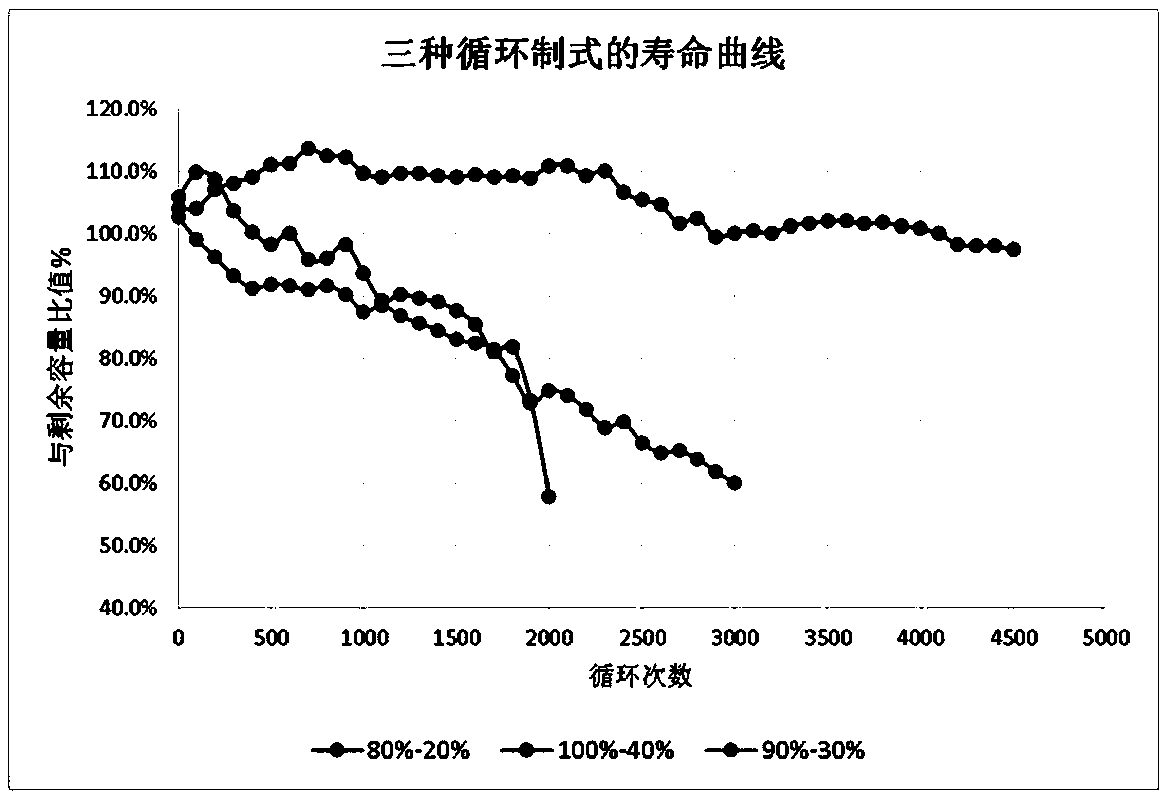Suitable for energy storage scenarios matching the undercharge cycle system of lead-carbon batteries
A lead-carbon battery and energy storage technology, applied in the field of under-charging cycle system, can solve the problems of battery dehydration, uncontrollable charging capacity, battery positive grid corrosion, etc., and achieve the effect of high cost performance of the battery
- Summary
- Abstract
- Description
- Claims
- Application Information
AI Technical Summary
Problems solved by technology
Method used
Image
Examples
Embodiment 1)
[0023] The invention includes the following devices:
[0024] One Jinfan equipment: its model is: 12V150Ah;
[0025] 18 lead-carbon batteries: model LLC-300Ah, 6 for each method;
[0026] Test environment: keep the normal temperature at 25°C;
[0027] Design parameters on Jinfan equipment for testing.
[0028] The technical solution of the present invention (the discharge depth is cycled between 80% and 20%) is as follows:
[0029] 1) If the battery C10 capacity is qualified, discharge it at 0.2C10A for 1h, and adjust the maximum state of charge to 80%;
[0030] 2) Discharge at 0.3C10A for 2h;
[0031] 3) Charge with constant voltage 2.32V / limited current 0.3C10A until the total charging capacity reaches 102% of the discharging capacity;
[0032] 4) Repeat steps 2 to 3 for 200 times, and charge at 2.32V / limited current 0.3C10 for 12 hours after 200 cycles;
[0033] 5) C10 capacity detection (terminal voltage average 1.80V / monomer), charge at 2.32V / limited current 0.15C10...
comparative approach 2
[0043] Comparison scheme 2: The depth of discharge is cycled between 100% and 40% (the current usage scheme of lead-acid batteries)
[0044] 1) The battery C10 capacity test is qualified;
[0045] 2) Discharge at 0.2C10A for 3h;
[0046] 3) Charge with constant voltage 2.35V / limited current 0.2C10A for 6h;
[0047] 4) Repeat steps 2 to 3 100 times, and charge at 2.35V / limited current 0.2C10 for 12 hours after 100 cycles;
[0048] 5) C10 capacity detection (terminal voltage average 1.80V / monomer), after discharge, charge at 2.35V / limited current 0.15C10A for 16h;
[0049] 7) Repeat steps 1 to 6. When the battery capacity is lower than 60% of the rated capacity of the 10h rate, record the number of cycles, and test again to confirm that it is still lower than 60%. The last 100 cycles are not included in the number of large cycles. .
[0050] Such as figure 1 , From the above test results, it can be explained that the 60% DOD cycle number can be increased by at least 2000 ti...
PUM
 Login to View More
Login to View More Abstract
Description
Claims
Application Information
 Login to View More
Login to View More - R&D
- Intellectual Property
- Life Sciences
- Materials
- Tech Scout
- Unparalleled Data Quality
- Higher Quality Content
- 60% Fewer Hallucinations
Browse by: Latest US Patents, China's latest patents, Technical Efficacy Thesaurus, Application Domain, Technology Topic, Popular Technical Reports.
© 2025 PatSnap. All rights reserved.Legal|Privacy policy|Modern Slavery Act Transparency Statement|Sitemap|About US| Contact US: help@patsnap.com

